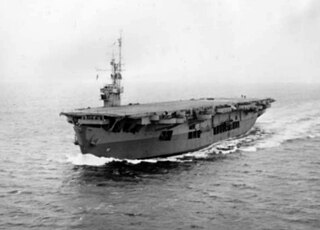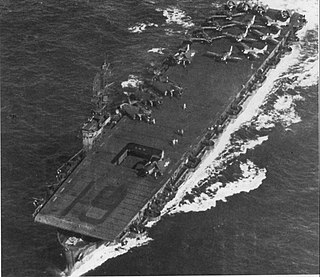
The Battle of Leyte Gulf was the largest naval battle of World War II and by some criteria the largest naval battle in history, with over 200,000 naval personnel involved. It was fought in waters near the Philippine islands of Leyte, Samar, and Luzon from 23 to 26 October 1944 between combined American and Australian forces and the Imperial Japanese Navy (IJN), as part of the invasion of Leyte, which aimed to isolate Japan from the colonies that it had occupied in Southeast Asia, a vital source of industrial and oil supplies.

USS Suwannee (CVE-27), was built as the civilian oiler Markay, in 1939, before being acquired by the US Navy, in 1941, and renamed Suwannee (AO-33), after the tradition of naming fleet oilers after rivers. In 1942, she was converted to a Sangamon-class escort carrier. Originally classified as an "Aircraft Escort Vessel", AVG-27, on 14 February 1942, she was reclassified an "Auxiliary Aircraft Carrier", ACV-27, 20 August 1942, before finally being classified as an "Escort Carrier", CVE-27, 15 July 1943. After the war, she was later classified an "Escort Helicopter Aircraft Carrier" and again redesignated, CVHE-27, 12 June 1955.

The Battle off Samar was the centermost action of the Battle of Leyte Gulf, one of the largest naval battles in history, which took place in the Philippine Sea off Samar Island, in the Philippines on October 25, 1944. It was the only major action in the larger battle in which the Americans were largely unprepared. After the previous day's fighting, the Imperial Japanese Navy's First Mobile Striking Force, under the command of Takeo Kurita, had suffered significant damages and appeared to be retreating westward. However, by the next morning, the Japanese force had turned around and resumed its advance toward Leyte Gulf. With Admiral William Halsey Jr. lured into taking his powerful Third Fleet north after a decoy fleet and the Seventh Fleet engaged to the south, the recently-landed 130,000 men of the Sixth Army were left vulnerable to Japanese attack on Leyte.

USS Gambier Bay (CVE-73) was a Casablanca-class escort carrier of the United States Navy. During the Battle off Samar, part of the overall Battle of Leyte Gulf, during a successful effort to turn back a much larger attacking Japanese surface force, Gambier Bay was sunk by naval gunfire, primarily from the battleship Yamato, taking at least 15 hits between 8:10 and 8:40. She was the only American aircraft carrier sunk by enemy surface gunfire during World War II.

USS St. Lo (AVG/ACV/CVE–63) was a Casablanca-class escort carrier of the United States Navy during World War II. On 25 October 1944, St. Lo became the first major warship to sink as the result of a kamikaze attack. The attack occurred during the Battle off Samar, part of the larger Battle of Leyte Gulf.

USS Kitkun Bay (CVE-71) was the seventeenth of fifty Casablanca-class escort carrier built for the United States Navy during World War II. She was launched in November 1943, and transferred to the Navy and commissioned in December. She served in the Mariana and Palau Islands campaign, the Battle off Samar, in which she was the first ship to undergo kamikaze attack, and the Invasion of Lingayen Gulf, during which she was damaged by another kamikaze and forced to withdraw. Post-war, she participated in Operation Magic Carpet, repatriating U.S. servicemen from around the Pacific. She was decommissioned in April 1946, and sold for scrapping in November. Ultimately, she was broken up in early 1947.

USS Kadashan Bay (CVE-76) was a Casablanca-class escort carrier of the United States Navy. It was named after Kadashan Bay, located within Chichagof Island. The bay in turn was named after Paul K. Kadashan, an Alaskan Indian who established a homestead incorporating the bay in 1915. Launched in December 1943, and commissioned in January 1944, she served in support of the Mariana and Palau Islands campaign, the Battle off Samar, and the Invasion of Lingayen Gulf. Postwar, she participated in Operation Magic Carpet. She was decommissioned in June 1946, when she was mothballed in the Atlantic Reserve Fleet. Ultimately, she was sold for scrapping in February 1960.

USS Kalinin Bay (CVE-68) was a Casablanca-class escort carrier of the United States Navy.

USS Fanshaw Bay (CVE-70) was a Casablanca-class escort carrier of the United States Navy. She was named after Fanshaw Bay, located within Cape Fanshaw, of the Alexander Archipelago in the Territory of Alaska. The cape was given its name by Charles Mitchell Thomas, who was mapping the area, in 1887. Built for service during World War II, the ship was launched in November 1943, and commissioned in December, and served in support of the Mariana and Palau Islands campaign, the Battle off Samar, and the Battle of Okinawa. Postwar, she participated in Operation Magic Carpet. She was decommissioned in August 1946, when she was mothballed in the Pacific Reserve Fleet. Ultimately, she was sold for scrapping in September 1959.

USS Marcus Island (CVE-77) was the twenty-third of fifty Casablanca-class escort carriers built for the United States Navy during World War II. She was named after an engagement on 31 August 1943 over Minami-Tori-shima, known on American maps as Marcus Island. She was launched in December 1943, commissioned in January 1944, and she served in the Mariana and Palau Islands campaign, the Philippines campaign, as well as the Battle of Okinawa. She spent the majority of her World War II as a flagship for various escort carrier formations, serving as the headquarters for Rear Admiral William D. Sample and Felix Stump. During the Philippines campaign, she participated in the Battle off Samar, the largest naval engagement in history, and during the Battle of Mindoro, she had multiple near-brushes with Japanese kamikazes. Post-war, she participated in Operation Magic Carpet, repatriating U.S. servicemen from throughout the Pacific. She was decommissioned in December 1946, being mothballed in the Atlantic Reserve Fleet. Ultimately, she was broken up in 1960.

USS Manila Bay (CVE-61) was a Casablanca-class escort carrier of the United States Navy.

USS Petrof Bay (CVE-80) was the twenty-sixth of fifty Casablanca-class escort carriers built for the United States Navy during World War II. She was named after Petrof Bay, which in turn was named in 1928 after Ivan Petroff, a Russian Alaskan who served as a special census agent for the 1880 United States census. The bay is located within Kuiu Island, which at the time was a part of the Territory of Alaska. The ship was launched in January 1944, commissioned in February, and served in support of the Mariana and Palau Islands campaign, the Philippines campaign, including the Battle off Samar, the Battle of Iwo Jima, and the Battle of Okinawa. She was decommissioned in July 1946, when she was mothballed in the Atlantic Reserve Fleet. Postwar, she participated in Operation Magic Carpet. Ultimately, she was broken up in September 1959.

USS Natoma Bay (CVE–62) was a Casablanca-class escort carrier of the United States Navy that served in the Pacific War during World War II. The carrier entered service in 1943 and participated in a series of operations in the South Pacific including the Philippines campaign, the Battle off Samar and the Battle of Okinawa. During the Okinawa battle, Natoma Bay was struck by a Japanese aircraft and heavily damaged, ending the ship's participation in the war. Once repaired, Natoma Bay was assigned to Operation Magic Carpet, the return of American soldiers from the Pacific theatre. Following the completion of the operation the escort carrier was decommissioned in 1946 and placed in reserve. In 1959, Natoma Bay was sold for scrap.

USS Saginaw Bay (CVE-82) was a Casablanca-class escort carrier of the United States Navy. It was named after Saginaw Bay, located within Kuiu Island. The bay was in turn named after USS Saginaw, a U.S. Navy sloop-of-war that spent 1868 and 1869 charting and exploring the Alaskan coast. Launched in January 1944, and commissioned in March, she served in support of the Mariana and Palau Islands campaign, the Philippines campaign, the Invasion of Iwo Jima, and the Battle of Okinawa. Postwar, she participated in Operation Magic Carpet. She was decommissioned in April 1946, when she was mothballed in the Atlantic Reserve Fleet. Ultimately, she was sold for scrapping in November 1959.

USS Savo Island (CVE-78) was the twenty-fourth of fifty Casablanca-class escort carriers built for the United States Navy during World War II. She was named to memorialize the U.S. casualties of the Battle of Savo Island, which was fought as part of the Guadalcanal campaign. The ship was launched in December 1943, commissioned in February 1944, and served as a frontline carrier throughout the Mariana and Palau Islands campaign and the Philippines campaign. During the Battle of Okinawa, she provided air cover for the replenishment carrier fleet. Postwar, she participated in Operation Magic Carpet, repatriating U.S. servicemen from throughout the Pacific. She was decommissioned in December 1946, when she was mothballed in the Atlantic Reserve Fleet. Ultimately, she was sold for scrapping in February 1960.

USS Heermann (DD-532) was a World War II-era Fletcher-class destroyer in the service of the United States Navy. The ship entered service in 1943 and took part in several battles during World War II in the Pacific theatre of operations, including the Philippines campaign, Battle off Samar and the Battle of Iwo Jima among others. Heermann gained fame during the "last stand of the Tin Can Sailors" in which she and several other destroyers of Task Unit 77.4.3 engaged a far superior Japanese task force during the Battle off Samar in October 1944. Heermann was the only American destroyer of "Taffy 3" to survive the engagement. Following the end of the war in 1945, the ship was placed in reserve from 1946 to 1951, when the destroyer was reactivated. Heermann remained in active service until 1957, when the ship was returned to the reserve. In 1961, Heerman was loaned to Argentina and was renamed ARA Almirante Brown (D-20) while in service with the Argentinian Navy. Almirante Brown remained in Argentinian service until 1982, when the ship was decommissioned.

USS John C. Butler (DE-339) was the lead ship of her class of destroyer escorts in the service with the United States Navy from 1944 to 1946. She was recommissioned between 1950 and 1957 and finally sunk as a target in 1971.

USS Helm (DD-388) was a Bagley-class destroyer in the United States Navy during World War II. She was named for Rear Admiral James Meredith Helm. Helm received 11 battle stars for her World War II service in the Pacific.

USS Tingey (DD-539) was a Fletcher-class destroyer of the United States Navy. She was the third Navy ship to be named for Commodore Thomas Tingey (1750–1829).

USS Haggard (DD-555) was a Fletcher-class destroyer of the United States Navy named for Captain Haggard of the Louisa, who fought in the Quasi-War.





















